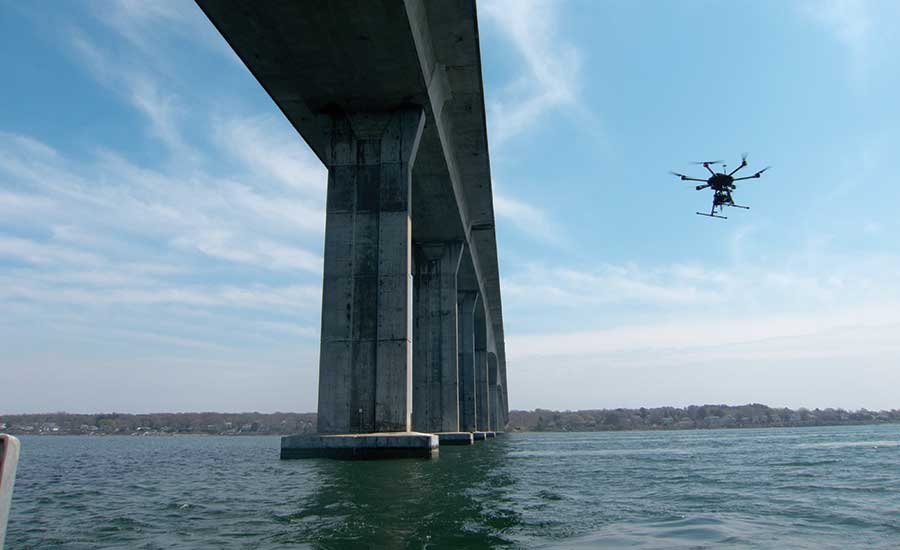Drones rapidly are becoming a game-changer for safety and efficiency in construction, agreed engineers and contractors discussing the technology at two recent conferences. But they also said drone providers still need to overcome some practical and regulatory obstacles.
Practical obstacles, especially for inspection of structures such as bridges, include the drone’s vulnerability to weather conditions and the sudden loss of GPS positioning when concrete or steel blocks satellite reception.
Regulatory issues include airspace access. For example, Chen Ahn, a Hawaiian Dredging Construction Co. construction engineer and drone operator, recounted waiting a year for an exemption from the Federal Aviation Administration so the company could fly a drone within 600 ft of an airport.
Yet Ahn and other panelists at a recent conference—called InterDrone, held in Las Vegas on Sept. 6-8—also gave examples of how drones are saving costs. For example, instead of spending $5,000 per hour on helicopter flights, firms are acquiring the same data from drones, at a cost of about $1,000 a week.
But challenges remain. A windy day can compromise the ability of a drone to maintain position in proximity to targets. “That’s why we’re reluctant to get too close to a structure now,” says Matt Sullivan, a project engineer with WSP. “Drones are expensive. Nobody wants to say, ‘I just hit the bridge.’ ”
At the InterDrone convention, vendors unveiled new models of drones. For example, Intel introduced the Falcon 8, which is designed to withstand wind gusts and some rain.
The International Bridge Conference, held in June at National Harbor, Md., also tackled the subject of drone-enabled inspections. Michael Rondinelli, director of product development for Near Earth Autonomy, an unmanned-aircraft technology company spun off from Carnegie Mellon University, described other technical challenges to bridge inspections using drones.
For example, long bridges over water pose special hazards, said Rondinelli, because “you can’t just land [the drone] anywhere you want.” Moreover, LiDAR pulses “reflect off the water surface and scatter off in random directions, so we have no idea how close we are when over the water,” Rondinelli added.
On Sept. 18, WSP and Near Earth Autonomy were poised to test the latter’s LiDAR-equipped Hummingbird prototype to inspect the Delaware Memorial Bridge; however, the approach of Hurricane Jose delayed the test. “We’ll see if the drone can fly within the truss structure of the bridge, between truss members and within a few feet of them,” said Sullivan.
Another of the goals of the Delaware test will be to see “if we can collect useful data from the bridge and provide the kind of context that is actionable and makes inspection data more valuable,” Rondinelli said.
Many Other Uses
In an InterDrone session on the latest in structural inspections, some panelists focused on drone damage assessments performed in Houston in the wake of Hurricane Harvey the week before, while others spoke of preparing for such assessments in Florida after Hurricane Irma’s expected landfall.
Before the hurricanes, drone services company Measure was using drones to check bridge and utility infrastructure for endangered species’ and hornets’ nests, as well as rust and missing structural members, said Christopher Moccia, executive vice president of infrastructure. After the storm, “we were involved [in Houston] with wireless operations to inspect infrastructure [damage],” he notes.
Art Pregler, drone program director for AT&T, said that part of AT&T’s preparations for Harvey included staging drone crews in San Antonio and deploying them post-storm to inspect cellphone towers. “There was a video feed to the war room so that the operations team could evaluate the impact and prioritize repairs,” he said. “We could better plan access routes into affected areas.”
Pregler added that, in a few years, drones equipped with onboard artificial intelligence will learn to recognize what they’re looking at, including identifying 200 different elements found on towers. “Drones with AI will identify equipment and make decisions based on the quality, initiating a trouble ticket to send a crew out,” he said.
Moccia predicted that, within 10 years, automation will be the norm. “Drones will do multiple missions—like emergency response or mapping—and then recharge themselves,” he stated.
But contractors already are benefitting, as the accuracy of drone-provided structural analysis improves, added Robert McCoy, quality assurance manager of corporate tower operations for Crown Castle. “3D models already have 1⁄30-in. accuracy,” he said.
Construction teams still are figuring out how to cope with the vast amount of data streaming from drones. “We need the bridge condition to be conveyed in a clear, concise way, not a 4,000-page report,” said Sullivan. But that process also is improving, said Bill Bennington, virtual construction manager with PCL. Just a few months ago, the data workflow was more cumbersome than it is now. New software advances let crews “fly, process and consume data—all on site,” he said.
Further, the technology can go a long way toward addressing the industry’s low productivity rates, added Tristan Randall, strategic projects executive with Autodesk. For example, Tomislav Zigo, director of virtual design and construction (VDC) for Clayco, described a recent three-day, drone scan of a site in St. Louis that reduced survey costs by 80%. Zigo cited another case study in which drones helped the client to quantify the amount of acidic soils to be excavated, resulting in a savings of $55,000. Richard Lopez, VDC manager with Hensel Phelps, reported that using drones to inspect a high-rise in Denver saved four days of mobilizing climbers and scaffold.
Remarking on the construction industry’s labor shortage, 3DR founder Chris Anderson said that, rather than having drones remain an esoteric technology, he envisions a future in which any worker on a construction site will be able to conduct a drone site scan. “If it [becomes] a dirty old box with a button—and it’s boring—it’s a success,” he said.





Post a comment to this article
Report Abusive Comment